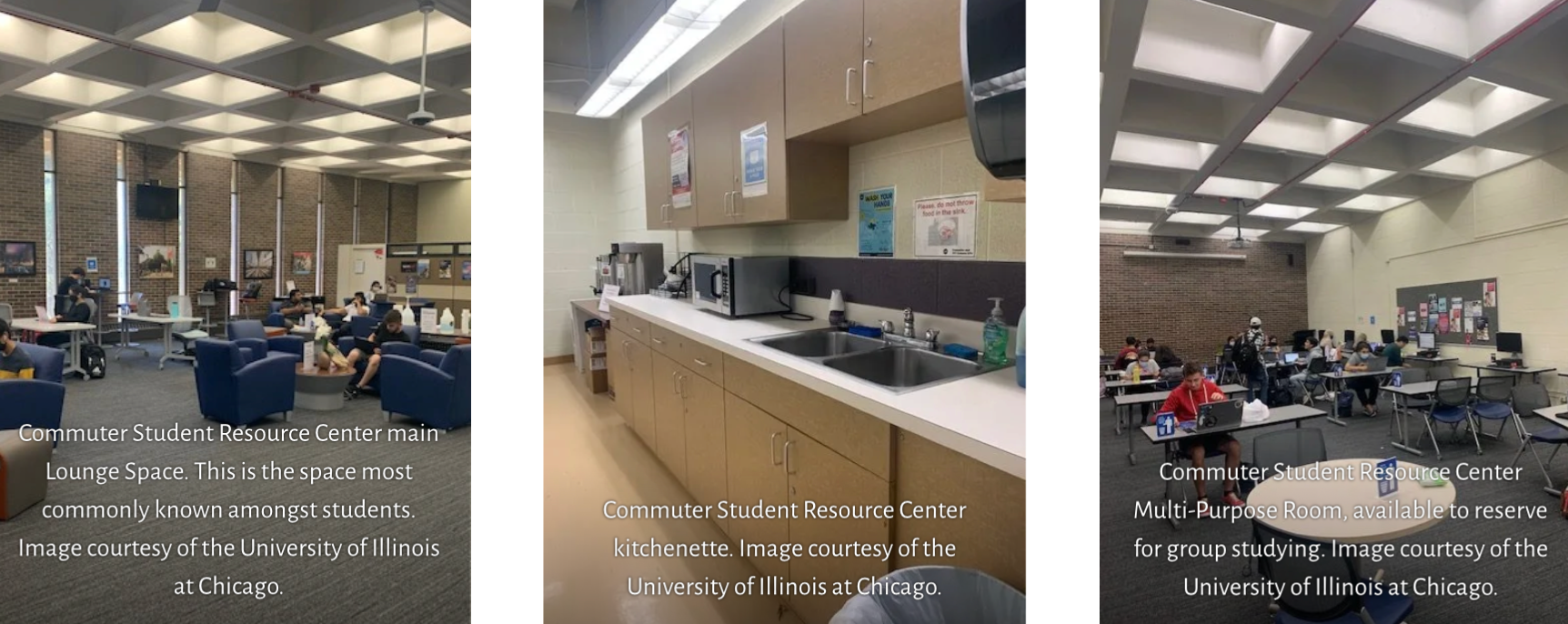Stuck on Campus With Nowhere to Sit
Unpacking the Commuter Experience at the University of Illinois at Chicago
In this feature story assignment for my professional writing course, we explored problems students on our campus, The University of Illinois at Chicago, are currently facing. For my story, I chose to investigate the struggles commuters face on campus, specifically the lack of available spaces on campus for commuters to go in-between classes. By researching the university and interviewing current students, I was able to write an investigative story exposing the problems with the current problems commuters are expected to navigate while at school. As a commuter student myself, this assignment felt near and dear to my heart.
April 14th, 2023 — Chicago
At the University of Illinois at Chicago (UIC), having a large, diverse student population is a key factor of school identity. With many students coming from surrounding areas in Chicago, the Chicagoland suburbs, and beyond, UIC is known for having one of the largest commuting student populations in Chicago. On a webpage from the Office of Diversity, Equity & Engagement, UIC states 80% of its enrolled students are commuters, ranking amongst the highest percentage of commuter students for all Chicago universities.
While commuting every day might not be the first thing that comes to mind when thinking about the "traditional" American college experience, UIC students -- and students at commuter schools all over the country -- are offered various benefits. Commuting provides an opportunity for students who do not want or cannot have a "traditional" university experience, such as those who must live at home, work full-time, or raise a family. With UIC’s relatively inexpensive tuition costs and convenient access to public transportation, it is not surprising that UIC appeals to a wide variety of students looking for flexible university options.
Jenin Alharithi, a senior and former commuter at UIC, remarks how she liked that commuting offered her a separation between school life versus her family, work, and social lives, stating that she misses having a life that felt "separate" from school when living in a southwest Chicago suburb. Now that she lives just five minutes from the school, she expresses the feeling that “everything revolves around the fact that this is school.”
While Jenin appreciates the benefits being so close to the heart of campus has to offer, commuting offered her a mental and physical separation between her different priorities.
Sara Dallash, a commuting junior at UIC, shares a similar sentiment, stating that she likes the way that commuting gives her “control over [her] time [she] spends on campus," allowing her to "pick how much time [she] wants to spend at school," which helps her balance her academic life with her mental health.
Everyone told me how hard it would be to make friends here, but I didn’t really believe them until I experienced it for myself.”
Many students are drawn to the low tuition prices and ability to come to campus on their own terms; commuting, however, comes with its own set of drawbacks just like anything else.
“Commuting is a very strenuous, mentally exhausting thing,” Alharithi states, reflecting on the times when she would spend an upmost of 2 hours on the train a day. “It takes a toll on your body and you’re constantly worried about being late for class.”
On top of the inconvenience of the extra time it takes just to get to campus, commuting can cause some students to feel isolated from the sense of pride and belonging on their campus, positive feelings commonly associated with the American university experience.
Emma Muhleman, a transfer student to UIC who lives on the UIC west campus but attends classes on the UIC east campus, states, “everyone told me how hard it would be to make friends here, but I didn’t really believe them until I experienced it for myself.”
Muhleman's is not an isolated experience, with commuter students commonly referring to UIC as lonely due the difficulty in finding a place they feel they fit in.
Aside from the emotional and social difficulties that affect commuters, UIC also has a number of logistical issues in the way the university cares for its commuters. Due to the nature class scheduling and timing at UIC, it is not uncommon for students to have breaks of at least an hour between classes, giving them free time before their next session. In theory, this free time would be good for a commuter, offering them time to eat their lunch or dinner, work on homework, or see their friends. While these breaks should be seen as a time of relaxation for students, unfortunately, many of these breaks can cause stress for commuters. With limited seating available on campus, it can be difficult for students to find a comfortable spot to wait for their next class.
UIC east campus offers a dedicated space for commuter students, called the Commuter Student Resource Center (CSRC). This area, buried deep in the corner of Student Center East’s second floor, offers a lounge, a study space, a kitchenette, a reservable multi-purpose room, and a lactation room. On paper, this space offers a very efficient variety of resources to help commuting students throughout their day: a place to store and heat their lunch, a shared space to gather with other fellow commuters, and a place to take care of their personal needs.
However, this space is not as efficient as it seems. Around lunch time is when students most commonly have breaks in between their classes and are looking to find a space to eat, study, and wait for their next class to begin. At this time, the CSRC tends to be very full, making it hard to find a space to claim.
When asked if she noticed if the CSRC is full the times she has stopped in there, Alharithi confessed that “it is usually pretty busy… so a lot of the spaces are usually occupied.”
While the lounge space seemingly act as a safe haven for students who do not have a dorm or close home of their own to return to while waiting in between classes, these spaces often become inaccessible to commuters, with only a small number of students being able to utilize the space at one time.

It is unfair that commuter students must rely on luck to be able to find a comfortable spot on campus. While the CSRS is just one spot where commuters are able to go during their downtime, this is supposed to be a spot in which commuting students can feel welcomed and comfortable. It seems inefficient to only have one commuter center on East Campus when the vast majority of students live off campus. With eight different residence halls spread out between UIC’s east and west campuses to serve the 20% of students who live on campus, why do we only have one dedicated commuter center to serve the 80% of students who commute?
While UIC offers a comprehensive list of many of the open study spots available to students on their website, many of the buildings have only small seating areas, which quickly fill up during the common times classes begin. Having to walk from building to building — especially in extreme weather conditions, like Chicago’s extreme cold and extreme hot temperatures — in hopes to find a spot to settle into is an uncomfortable inconvenience. Even when you reach these spots listed on the UIC website under “commuter resources,” such as the lobby of the Academic and Residential Complex (known as the ARC) or the Student Center East's Circle Lounge, there are no guarantees that these areas will have an available spot to sit, as they fill up just as fast as the commuter center.
During her interview, Muhleman recalled a time in the past when she was looking for a spot to study in between classes but did not know where to go. She described the way she had to wander around campus in the cold to find a building with available seating, ultimately having to end up “eating [her] lunch on the floor.”
With Chicago offering a variety of cafés and restaurants, there are, of course, other places in the surrounding area that students may go. But these places can take more time to get to, taking away from a student's time to eat, relax, and/or study. On top of this, this may put students facing financial difficulties in a difficult position, as not every student may have the disposable income needed to attend these places. If students are already paying tuition to attend a school, they should not have to spend money in another spot off campus out of necessity because they had nowhere to go on their campus.
I would like to see change in the university… I know the university welcomes me, but I would like to see it in action.”
With all this being said, what is next for the future of commuting students at the University of Illinois at Chicago? It seems to be a common consensus that commuting students would like to see a change in the available space offered to them at UIC. The creation of more lounges in spaces that are not currently being utilized, the rearrangement of the lounges already present to maximize capacity, and the addition of resources such as microwaves and fridges to existing spaces could all be possible ideas the university may consider.
While the 80% of students commuting to UIC are told that the university belongs to them just as much as it belongs to students living on campus, there still must be changes made to make these commuters feel more welcomed. Dallash puts it best when she states, “I would like to see change in the university… I know the university welcomes me, but I would like to see it in action.” ✧
Something you loved about this piece? Questions, comments, concerns? Let me know!

Post a comment